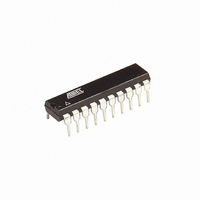ATTINY2313A-PU Atmel, ATTINY2313A-PU Datasheet - Page 35

ATTINY2313A-PU
Manufacturer Part Number
ATTINY2313A-PU
Description
IC MCU AVR 2K FLASH 20MHZ 20DIP
Manufacturer
Atmel
Series
AVR® ATtinyr
Specifications of ATTINY2313A-PU
Core Processor
AVR
Core Size
8-Bit
Speed
20MHz
Connectivity
I²C, SPI, UART/USART
Peripherals
Brown-out Detect/Reset, POR, PWM, WDT
Number Of I /o
18
Program Memory Size
2KB (1K x 16)
Program Memory Type
FLASH
Eeprom Size
128 x 8
Ram Size
128 x 8
Voltage - Supply (vcc/vdd)
1.8 V ~ 5.5 V
Oscillator Type
Internal
Operating Temperature
-40°C ~ 85°C
Package / Case
20-DIP (0.300", 7.62mm)
Processor Series
ATTINY2x
Core
AVR8
Data Bus Width
8 bit
Data Ram Size
128 B
Interface Type
SPI, USART
Maximum Clock Frequency
20 MHz
Number Of Programmable I/os
18
Operating Supply Voltage
1.8 V to 5.5 V
Maximum Operating Temperature
+ 85 C
Mounting Style
Through Hole
3rd Party Development Tools
EWAVR, EWAVR-BL
Development Tools By Supplier
ATAVRDRAGON, ATSTK500, ATSTK600, ATAVRISP2, ATAVRONEKIT
Minimum Operating Temperature
- 40 C
Controller Family/series
ATtiny
No. Of I/o's
18
Eeprom Memory Size
128Byte
Ram Memory Size
128Byte
Cpu Speed
20MHz
Rohs Compliant
Yes
Lead Free Status / RoHS Status
Lead free / RoHS Compliant
Data Converters
-
Lead Free Status / Rohs Status
Lead free / RoHS Compliant
Available stocks
Company
Part Number
Manufacturer
Quantity
Price
Company:
Part Number:
ATTINY2313A-PU
Manufacturer:
TI
Quantity:
1 560
Part Number:
ATTINY2313A-PU
Manufacturer:
ATMEL/爱特梅尔
Quantity:
20 000
7.4
7.4.1
7.4.2
7.4.3
7.4.4
7.4.5
8246A–AVR–11/09
Minimizing Power Consumption
Analog Comparator
Internal Voltage Reference
Brown-out Detector
Watchdog Timer
Port Pins
Peripheral shutdown can be used in Idle mode and Active mode to significantly reduce the over-
all power consumption. See
sleep modes, the clock is already stopped.
There are several issues to consider when trying to minimize the power consumption in an AVR
controlled system. In general, sleep modes should be used as much as possible, and the sleep
mode should be selected so that as few as possible of the device’s functions are operating. All
functions not needed should be disabled. In particular, the following modules may need special
consideration when trying to achieve the lowest possible power consumption.
When entering Idle mode, the Analog Comparator should be disabled if not used. In the other
sleep modes, the Analog Comparator is automatically disabled. However, if the Analog Compar-
ator is set up to use the Internal Voltage Reference as input, the Analog Comparator should be
disabled in all sleep modes. Otherwise, the Internal Voltage Reference will be enabled, indepen-
dent of sleep mode. See
Analog Comparator.
The Internal Voltage Reference will be enabled when needed by the Brown-out Detection or the
Analog Comparator. If these modules are disabled as described in the sections above, the inter-
nal voltage reference will be disabled and it will not be consuming power. When turned on again,
the user must allow the reference to start up before the output is used. If the reference is kept on
in sleep mode, the output can be used immediately. See
41
If the Brown-out Detector is not needed in the application, this module should be turned off. If the
Brown-out Detector is enabled by the BODLEVEL Fuses, it will be enabled in all sleep modes,
and hence, always consume power. In the deeper sleep modes, this will contribute significantly
to the total current consumption. See
able” on page 34
If the Watchdog Timer is not needed in the application, this module should be turned off. If the
Watchdog Timer is enabled, it will be enabled in all sleep modes, and hence, always consume
power. In the deeper sleep modes, this will contribute significantly to the total current consump-
tion. See
When entering a sleep mode, all port pins should be configured to use minimum power. The
most important thing is then to ensure that no pins drive resistive loads. In sleep modes where
the I/O clock (clk
no power is consumed by the input logic when not needed. In some cases, the input logic is
needed for detecting wake-up conditions, and it will then be enabled. See the section
Input Enable and Sleep Modes” on page 57
buffer is enabled and the input signal is left floating or has an analog signal level close to V
the input buffer will use excessive power.
for details on the start-up time.
“Interrupts” on page 47
I/O
for details on how to configure the Brown-out Detector.
) is stopped, the input buffers of the device will be disabled. This ensures that
“Analog Comparator” on page 167
“Effect of Power Reduction” on page 203
for details on how to configure the Watchdog Timer.
“Brown-out Detection” on page 40
for details on which pins are enabled. If the input
“Internal Voltage Reference” on page
for details on how to configure the
for examples. In all other
and
“Software BOD Dis-
“Digital
CC
/2,
35















